
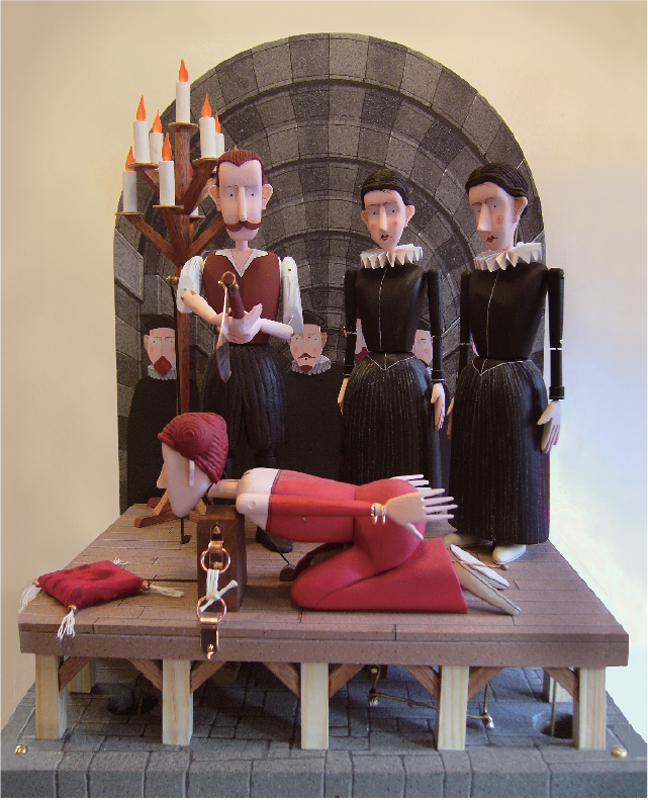

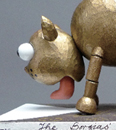
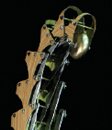

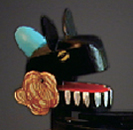


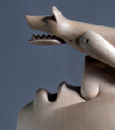
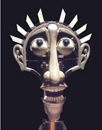


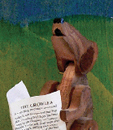
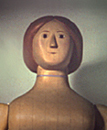
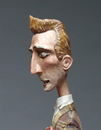
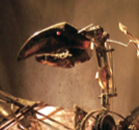
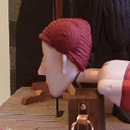
Crank and Motor-Powered Automata differ from puppets in that no skilled human operator is needed to make them function.
Instead of the puppeteer's hands, a crank, which can be turned by anyone, or an electric motor, which can be turned on by a switch, powers the mechanism.
Modern automata are mostly of this kind. Where earlier types of automata, powered by clockwork, closely imitated human or animal movements and activities, and amazed viewers by their realism, modern automata tend to be less realistic
and more imaginative, using abstract, fanciful, often humorous imagery, and narratives that seem to be based on a completely different view of "reality".
Some modern automata, like Tom Haney's Crescendo, or Walter Einsel's Wheel Ballerina, do imitate ordinary activities,
but put a humorous "spin" on them, or add a dash of unreality.
Our Fairy Queen, a display figure done for a shop window, shows a realistic woman, who then opens her body to surprise the viewer with a constantly changing light sculpture.
Some, like Neil Hardy's Growler, have an animal, in this case a dog, in a human activity but reverting to type at the full moon. Paul Spooner's The Borgia's Cat
acts like a cat…lapping up spilled milk, but collapses hilariously at intervals because, after all, he is the Borgia's cat.
Even when a modern automaton pictures an historic incident, it often does so with humor and great irony,
as is the case with Keith Newstead's execution of Mary Queen of Scots.
Some automata take unreality farther….creating a reversal of a normal situation, like Ron Fuller's Sheep Shearing Man, where a little human figure is decapitated by a laughing sheep.
Some create ridiculous situations, like Jan Zalud's Dog on Nose. Pablo Lavezzari's Urban Face imitates human movement and expression, but exaggerates it far beyond reality.
And some pieces, like Chris Fitch's Spring, take their inspiration, not from humans or animals, but from unfolding plant forms. Another category of automata, the coin-operated automaton,
like David Archer's Skull of Truth requests a donation to perform…in this case, to tell your fortune.
Skull of Truth incorporates simple electronics and a sound system;
more complex electronics is shown for Michael Curry's large and impressive Trash Phoenix, a
trashcan which transforms itself into a giant fiery bird.
The pictures: Newstead's Execution of Mary, Queen of Scots, photo and drawing. Spooner's The Borgia's Cat.
Fitch's Spring, photo and drawing. Fuller's Sheep Shearing Man, photo and drawing. David Archer's Skull of Truth.
Jan Zalud's Dog on Nose. Lavezzari's Urban Face and drawing. Our studio's Fairy Queen.
Neil Hardy's Growler. Walter Einsel's Wheel Ballerina. Tom Haney's Crescendo and Michael Curry's Trash Phoenix.
For a look at one of the experimental models for Spring, see the Supplementary Material section of this website Spring page in the Supplementary Materials section.
Additional drawings and schematics can also be found for the Trash Phoenix in the Supplementary Materials section.